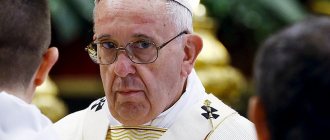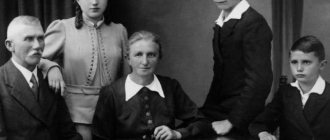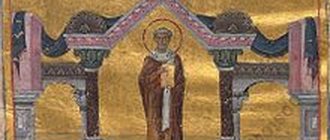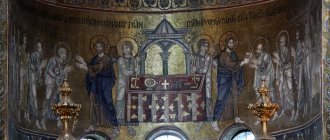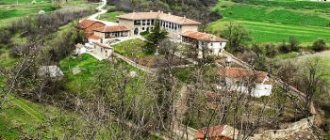The history of the formation of Orthodoxy in Rus' is inextricably linked with a number of individuals who dedicated their lives to the true worship of God and the fulfillment of all Divine laws. Strictly following the requirements of their religion, these people deserved Divine grace and the title of Orthodox saints for their selfless service to the Almighty and intercession for the entire human race before him.
The list of godly personalities who became famous for righteous deeds or who suffered for the faith of Christ is truly inexhaustible. Nowadays, it is also replenished with new names of pious Christians canonized by the church. The acquisition of holiness by ascetics of spiritual improvement can be called a great work, coupled with the burden of overcoming base feelings and vicious desires. Creating the Divine image in oneself requires enormous effort and painstaking work, and the feat of Orthodox saints awakens admiration in the souls of true believers.
On icons depicting the righteous, their heads are crowned with a halo. It symbolizes the grace of God, illuminating the face of a person who has become a saint. This is God's gift, warming the soul with the warmth of spirituality, delighting the heart with Divine radiance.
Hierarchy of the miracle-working fathers of the Orthodox Church
Through prayers in churches and prayer chants, clergy, together with believers, glorify the image of the earthly life of the righteous according to their rank or title. Taking into account the feats accomplished during life or the reasons for leaving for another world, on the pages of the Orthodox calendar compiled by the Russian Orthodox Church, lists of pious persons by rank are presented.
- Prophets. This is the name given to the Old Testament saints, endowed with the gift of foreseeing future events. The Prophets were chosen by the Almighty; they were called upon to prepare the people for the acceptance of Christianity.
- The best followers of the Lord are called apostles. Of these, 12 saints are called close, the ranks of the disciples of the Heavenly King number 70 righteous people.
- The Forefathers include the pious men mentioned in the Old Testament, who were distantly related to our Savior.
- Righteous men or women who have accepted monastic rank (monasticism) are called venerables.
- The status of great martyrs or martyrs is given to God-pleasers who died a martyr's death for the faith of Christ. Servants of the church are classified as hieromartyrs, sufferers in monasticism - venerable martyrs.
- Among the Blessed are the pious who have become insane for Christ's sake, as well as travelers without a permanent home. For their obedience, such people were gifted with God's mercy.
- Enlighteners (equal to the apostles) are called righteous people whose actions contributed to the conversion of peoples to the Christian faith.
- Passion-bearers or confessors are the name given to pious believers who were subjected to persecution and imprisonment for their devotion to the Savior. In the world, such Christians died in great pain.
Prayers to the holy saints are associated not only with the veneration of God’s companions, but with turning to them for their own help. Showing Divine honors and worshiping anyone other than the true and one God is prohibited according to the Holy Scriptures.
Holy Equal-to-the-Apostles Grand Duchess Olga
The Holy Equal-to-the-Apostles Grand Duchess Olga in 903 became the wife of the Grand Duke of Kyiv Igor. After his murder in 945 by the rebel Drevlyans, she, not wanting to marry again, took on the burden of public service with her three-year-old son Svyatoslav. In 954, Princess Olga went to Constantinople for the purpose of a religious pilgrimage and a diplomatic mission, where she was received with honor by Emperor Constantine VII Porphyrogenitus. The grandeur of Christian churches and the shrines collected in them impressed the princess so much that she decided to accept baptism, which was performed on her by Patriarch Theophylact of Constantinople, and the emperor himself became her successor. The name of the Russian princess was given in honor of the holy Queen Helen. Upon returning from Byzantium, Olga zealously carried the Christian gospel to the pagans, and began to erect the first Christian churches: in the name of St. Nicholas over the grave of the first Kyiv Christian prince Askold and St. Sophia in Kiev over the grave of Prince Dir. Holy Princess Olga reposed in 969, bequeathing her open Christian burial. The incorrupt relics of the princess rested in the Tithe Church in Kyiv.
However, the widespread spread of Christianity in Rus' was destined to begin only under the grandson of the holy Equal-to-the-Apostles Princess Olga - Equal-to-the-Apostles Prince Vladimir.
List of the most revered saints of the Orthodox Church by year of their life
- Apostle Andrew the First-Called is one of the 12 disciples of Christ, chosen by him to preach the Gospel. The disciple of John the Baptist received the status of the First Called for being the first to respond to the call of Jesus and also calling Christ the Savior. According to legend, he was crucified around the year 67 on a specially shaped cross, later called St. Andrew's. December 13 is the day of veneration by the Orthodox Church.
- Saint Spyridon of Trimifunt (207-348) became famous as a miracle worker. The life of Spyridon, elected bishop of the city of Trimifunt (Cyprus), was spent in humility and calls to repentance. The saint became famous for many miracles, including the revival of the dead. An adherent of strict observance of the words of the Gospel passed away while reading a prayer. Believers keep the icon of the miracle worker at home to receive God’s grace, and on December 25 they honor his memory.
- Of the female images, the most revered in Russia is the Blessed Matrona (1881-1952). The Orthodox saint was chosen by the Almighty for good deeds even before her birth. The difficult life of the righteous woman was permeated with patience and humility, with miracles of healing documented in writing. Believers venerate the relics of the passion-bearer, preserved within the walls of the Intercession Church, for healing and salvation. The day of veneration by the church is March 8.
- The most famous of the righteous, Nicholas the Ugodnik (270-345), is listed as Nicholas of Myra in the list of great saints. As a bishop, a native of Lycia (Roman province) devoted his entire life to Christianity, pacified the warring, defended the innocently convicted, and performed miracles of salvation. Believers turn to the icon of St. Nicholas the Pleasant for mental and physical healing, and protection for travelers. The Church honors the memory of the miracle worker with prayers on December 19 according to the new (Gregorian) style.
Due to numerous requests from readers, we have prepared an “Orthodox Calendar” application for smartphones. Every morning you will receive information about the current day: holidays, fasts, days of remembrance, prayers, parables. Download for free: Orthodox Calendar 2021 (available on Android)
Prayer to Nicholas the Ugodnik for help:
After the desired is realized, it is important to offer a prayer of gratitude to the saint:
Touching the myrrh-streaming relics of the Wonderworker, kept in the Catholic monastery of Bari (Italy), blesses believers with healing. You can pray to Nicholas the Pleasant anywhere.
The emphasis of Orthodox teaching is based on the spiritual principle of purposeful movement towards achieving holiness throughout a sinless life. An important advantage of holiness according to Orthodox teaching is the constant communication with God of the apostles who are in the Kingdom of Heaven.
Book "The First Christian Saints"
Audio |
Our Lord Jesus Christ called His closest disciples apostles. They were messengers, disciples of Christ, they were closest to Him and listened to His holy teaching more than anyone else. In order to reveal His omnipotence to the world, Christ chose and endowed with miraculous power almost all the apostles from poor, humble births. And those, being called to the apostleship, left their relatives, their homes and occupations and inseparably followed the Teacher. Preaching throughout cities and countries, they willingly shared with Him all the hardships and suffering. These were the first 12 apostles who knew and saw Jesus with their own eyes. But besides them, there were also 70 apostles, those who also labored in the field of the Gospel and enlightened various countries with the light of Christian teaching. The life and deeds of the “First Christian Saints” are told in a book of the same name, published by Eksmo Publishing House. More on this book later in our program. ***
This book, according to the publishers, contains information about all the famous first Christian saints: the apostles, disciples of Christ, believers mentioned in the New Testament and known from the Holy Tradition of the Church. As the author notes, with trepidation and respect he began to fulfill a plan that had long been languishing in his heart - to collect together hagiographic information about the apostles, about the early disciples of Christ, and abundantly decorate them with good illustrations. The main thing that had to be feared, and what the author feared with tireless attentiveness, was not to introduce anything of his own, personal into the hagiographic descriptions, not to obscure the traditions that had developed over centuries with his own, even obviously correct, opinion.
It was also important, according to the writer, to grasp the “measure of language.” If you preserve some of the ornateness of old church books, you can scare away the modern reader, who has long been unaccustomed to such ceremonial communication. If we completely modernize the language of primary sources, then there is a danger of losing a fertile linguistic tradition that is perceived not only by the earthly reader. The book has three parts: “Apostles from the 12”, “Apostle Paul” and “Apostles from the 70”. At the end of the story, two auxiliary dictionaries are provided, where the biblical names and geographical names mentioned in the book are briefly deciphered.
Opening the first part, we read: “When the time came, Jesus Christ, having been baptized by John in the Jordan River, began to preach the Divine Christian teaching, performing many miracles and healing from diseases: “And Jesus walked throughout all Galilee, teaching in their synagogues and preaching the gospel of the kingdom, and healing every sickness and every disease among the people.” People flocked from all over Judea to listen to Him. All of them usually returned then to everyday everyday activities. But there were also those who accompanied the Savior almost everywhere and were already called His disciples. And the time has come to highlight among them some of the chosen ones, those most worthy for decisive and open service to the human race. One evening the Lord retired to a secluded mountain to pray and spent the whole night there in prayer. And when morning came, Jesus Christ called his disciples to Himself and here, far from worldly noise, chose twelve of them closest to them.
All of these were for the most part simple people, poorly educated, poor Galilean fishermen with a pure and bright soul, not clouded by the pride of false enlightenment. The Lord chose them as having proven their love and affection for Him. He took upon Himself their education, teaching them in word and deed alone and before the people, at home and on the road, on land and at sea. He revealed to them the secrets of His coming, explained His teaching. Gradually he corrected their prejudices, brought from Jewish teaching, pacified their heart movements and brought them into agreement with their duties. The disciples were constantly with Him, accompanied Him everywhere, were His constant companions and interlocutors, witnesses of His miracles, suffering, death, resurrection and ascension into heaven.
At first they were in relation to the Lord as disciples. At the end of His earthly career, He already called them friends, from whom He did not hide anything. Finally, after His resurrection, He called them brothers, as the people closest to Him. And He also called them apostles, that is, messengers. In the first days, having given them the power to perform miracles, the Lord sent disciples to preach only to the inhabitants of Judea. Then, after his death and glorious resurrection, he sent to preach the Gospel to all nations, saying: “Go therefore and teach all nations, baptizing them in the name of the Father and the Son and the Holy Spirit.” The number “12,” broken by the fall of Judas, was soon replenished by the election of Matthias by lot after the Ascension of Christ. On the day of Pentecost, the apostles received the Holy Spirit, who descended in the form of fiery tongues. Illiterate, unskilled in words, simple fishermen began to understand all the dialects of the world, speak all languages, and received the ability and power to preach the Gospel to all nations.
The apostles traveled tens of thousands of kilometers preaching. Apostolic roads stretch in all four directions from Israel: Syria, Turkey, Georgia, Armenia, Azerbaijan, Russia in the east, Cyprus, Greece, Italy, Spain in the west, Britain, Scotland in the north, Egypt, African countries in the south . It was a great, sacrificial time. Of the 12 closest apostles, 11 died. Only Saint John the Theologian lived to a ripe old age and peaceful death. Of the 70 younger apostles, 36 suffered martyrdom—every second one. A new era began and strengthened, the era of the New Testament, a new calendar, the era of Christianity.
As stated in the third part of the book, in addition to the twelve apostles, the Lord Jesus Christ chose seventy others. The Evangelist Luke speaks about it this way: “After these things the Lord chose seventy other disciples, and sent them two by two before Him.” Twelve were with Him as witnesses of His life, and seventy prepared people to receive the Savior, preaching in those cities that He intended to visit. The now revered Council of the Seventy Apostles did not take shape right away. Many of the disciples, including the seventy, fell away from Christ over time and stopped serving Him. The Evangelist John writes about this: “...Many of His disciples departed from Him and no longer walked with Him.” When the days of Christ's suffering came, the number of Christ's disciples decreased even more. After the resurrection of Jesus Christ, the face of the holy twelve apostles was replenished by Matthias, but the face of the seventy was filled not immediately, but little by little, from among those who were converted to Christ by the twelve apostles and the preaching of the Apostle Paul, called by the Lord Himself.
Having listed the names of the apostles, the author notes that not all of them were among those 70 disciples whom the Lord Himself chose before starting the path to free passions. They are mentioned in later texts of the New Testament. So, for example, the conversion of Barnabas is spoken of only in the book of the Acts of the Apostles, Apollos came from Alexandria already during the missionary travels of the Apostle Paul, Onesimus was brought to Christ by the Apostle Paul, Aquila could not be in Galilee during the earthly preaching of Christ. Among the 70 apostles of St. Demetrius of Rostov, Kodrat and Cephas are also mentioned, then three apostles are mentioned, with the name Mark. The desire to unite them with those disciples whom Christ Himself chose and calling them apostles means that in their ministry the Church saw a continuation of the work for which the Lord sent the 12 and 70 apostles.
*** According to the publishers, in the book “The First Christian Saints” readers will find stories about people and shrines revered by all Orthodox believers, and numerous illustrations selected specifically for this book give each reader the opportunity to see the most valuable thing in the great heritage of the Church, keeping the memory of her first days. Read this book yourself, give it to your loved ones - after all, only through knowledge of the great deeds of witnesses to the earthly life of Jesus Christ can we understand what actually happened to our world more than 2000 years ago.
List of Russian Orthodox saints canonized in the 19th century
| Naming a saint (secular name) | Sainthood status | Brief information about the canon | Day of Remembrance | Years of life |
| Seraphim of Sarov (Prokhor Moshnin) | Reverend | The great ascetic and wonderworker predicted that his death would “be revealed by fire” | January 2 | 1754-1833 |
| Ksenia Petersburgskaya (Ksenia Petrova) | Blessed righteous woman | A wandering nun of a noble family who became a holy fool for Christ's sake | February 6 | 1730-1806 (date approximate) |
| Ambrose Optinsky (Alexander Grenkov) | Reverend | The great deeds of the Optina elder are associated with blessing his flock for charitable deeds and guardianship of the women's monastery | October 23 | 1812-1891 |
| Filaret (Vasily Drozdov) | Saint | Thanks to the Metropolitan of Moscow and Kolomna, Christians of Russia listen to the Holy Scriptures in Russian | November 19 | 1783-1867 |
| Feofan Vyshensky (Georgy Govorov) | Saint | The theologian distinguished himself in the field of preaching, voluntarily chose seclusion to translate ascetic books | January 18 | 1815-1894 |
| Pelageya Diveevskaya (Pelageya Serebrennikova) | Blessed | The nun became a holy fool for Christ’s sake according to the will of Seraphim of Sarov. For her feat of foolishness she was persecuted, beaten, and chained | 12th of February | 1809-1884 |
The act of canonization of righteous Christians can be either church-wide or local. The basis is holiness during life, the performance of miracles (intravital or posthumous), incorruptible relics. The result of the church's recognition of the saint is expressed by a call to the flock to honor the righteous man with prayers during public services, and not by commemoration. The ancient Christian church did not carry out the canonization procedure.
Saintly activity
In 370 he became metropolitan of Caesarea. He actively fought against the Arian heresy, wrote books and preached. Due to the active struggle against the heresy of Arius, he faced a conflict with Emperor Valens. He was an adherent of this heresy and reduced the scope of the saint's activities. But Vasily was not at a loss and instead nominated his like-minded people to the episcopal posts - Gregory the Theologian and Gregory of Nyssa.
Soon the emperor was killed, but this no longer helped the saint. He died in 379 at the age of fifty.
List of pious righteous people who received the rank of sainthood in the 20th century
| Name of a great Christian | Sainthood status | Brief information about the canon | Day of Remembrance | Years of life |
| John of Kronstadt (John Sergiev) | Righteous | In addition to preaching and spiritual writing, Father John healed the hopelessly sick and was a great seer | 20th of December | 1829-1909 |
| Nikolai (Ioann Kasatkin) | Equal to the Apostles | The Bishop of Japan was engaged in missionary work in Japan for half a century, spiritually supporting Russian prisoners | February 3rd | 1836-1912 |
| Vladimir (Vasily Bogoyavlensky) | Hieromartyr | The activities of the Metropolitan of Kyiv and Galicia were associated with spiritual enlightenment to strengthen Orthodoxy in the Caucasus. Accepted martyrdom during the persecution of the church | The 25th of January | 1848-1918 |
| Royalty | Passion-bearers | Members of the royal family, led by Emperor Nikolai Alexandrovich, who suffered martyrdom during the revolutionary coup | 4th of July | Canonization was confirmed by Russia in 2000 |
| Tikhon (Vasily Belavin) | Saint | The life of His Holiness the Patriarch of Moscow and All Rus' was connected with the glorification of the faces of saints. The confessor was a missionary in America, spoke out against the persecution of the Orthodox Church | March 25 | 1865-1925 |
| Silouan (Simeon Antonov) | Reverend | Having left the monastic path, he served in the army, where he supported his comrades with wise advice. Having taken monastic vows, he retired to the monastery to gain ascetic experience in fasting and prayer. | 11 September | 1866-1938 |
In Orthodox literature there is a special genre that describes the life and exploits of people who lived in holiness. The lives of saints are not secular chronicles, but life stories written in accordance with church canons and rules. The first records of events in the lives of holy ascetics were kept at the dawn of Christianity, then they were formed into calendar collections, lists of days of veneration of the blessed memory of saints.
According to the instructions of the Apostle Paul, preachers of the word of God should be remembered and their faith should be imitated. Despite the departure to another world of the holy righteous, whom the holy church reveres.
For high morality and holiness throughout the history of Orthodox Rus', people with a pure heart and a radiant soul were gifted with God's grace. They received the heavenly gift of holiness for their righteous deeds, their help to people living on earth is invaluable. Therefore, even in the most hopeless situation, go to church, pray to the saints, and you will receive help if the prayer is sincere.
What is the “old man” talking about?
You need to look at what a person’s life is centered around. Listen to some of the “elders” - they talk about the Antichrist, death, temptations, sin. You won’t hear about Christ from them! But our faith is Christ-centric, we must focus on Him - and not on the Antichrist, codes, Satan, and so on. Antichrist, like Judas or Pilate, is part of the history of Christianity. We do not focus on Judas, on his sin - we are waiting for the coming of Christ, looking forward to the resurrection of the dead! Yes, the Antichrist will come - but his presence will be temporary, humanity will survive the period of his stay on earth. Why should we focus on it if we must cleave to Christ? If you study the legacy of the holy fathers and isolate what they write about the Antichrist, it will be a tiny page in a multi-volume publication, and everything else is about Christ. So we need to figure out why the spiritual authority is trying so hard to gain dividends, why does it excite the minds of its followers? The fact is that if you tell a person: “Repent!” - he is unlikely to happily follow you, but if you say: “Everyone has sold out, you and I are the only righteous ones!” - he's yours.
Blessed Princes Boris and Gleb
One of the first saints of God, canonized by our Church, are the holy brothers - the noble princes Boris and Gleb, the sons of the holy Equal-to-the-Apostles Prince Vladimir. They were canonized as passion-bearers, since they accepted a violent death, however, not for the name of Christ, but due to the political ambitions of their brother Svyatopolk, who wanted to concentrate the grand-ducal power in his hands. Saints Boris and Gleb are examples of the true love of Christ: knowing that their brother wanted to kill them, they could gather troops to resist, however, not wanting anyone else’s blood to be shed in internecine wars, they decided to sacrifice their lives for the sake of the benefits of the fatherland.

